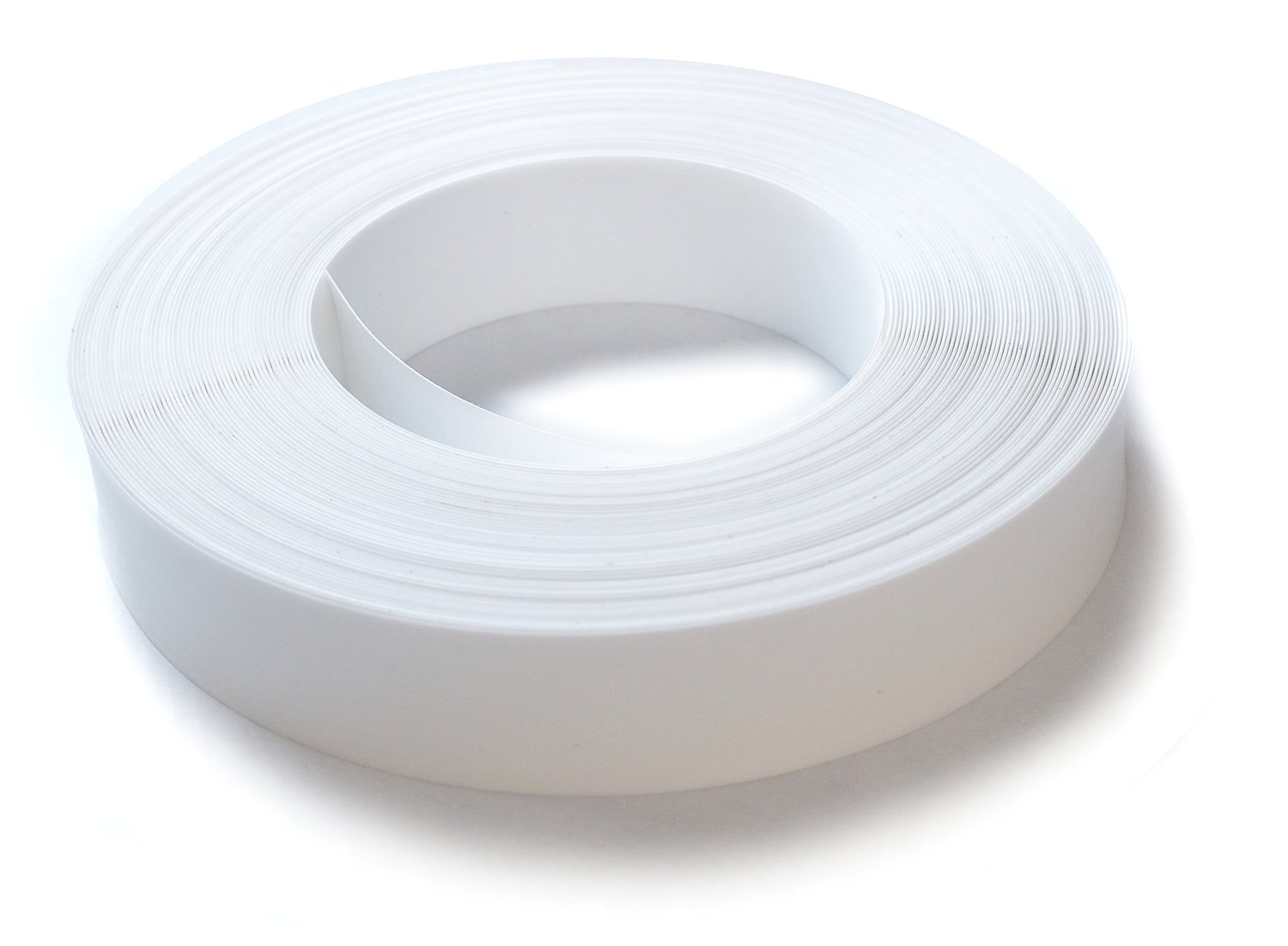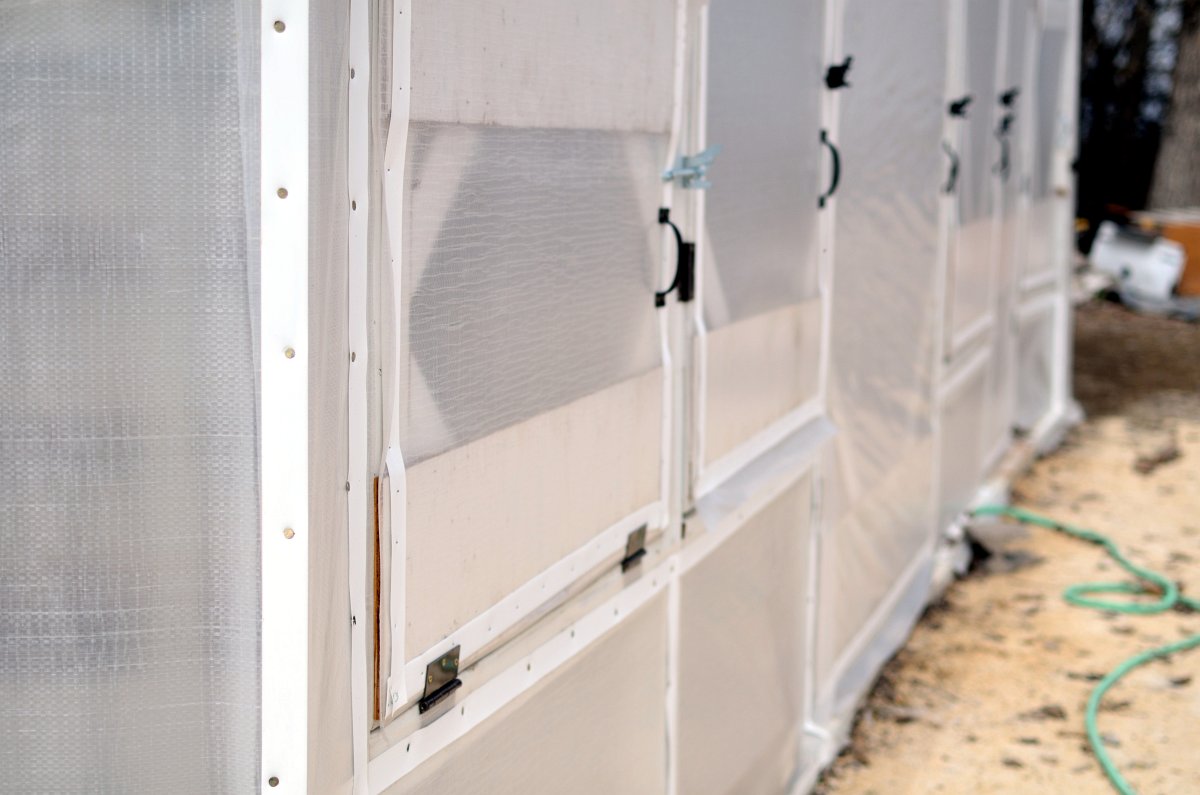installation, fastening & attachment
Using Cinchstrap
Cinchstrap is a flexible but tough and durable flat plastic lath. It has a clean white color. It is 1 13⁄16 " wide (almost 2 inches) and made of high-density poly plastic, exactly the same material used in our Polyfastener, but thinner.
Uses For Cinchstrap
Securing Poly Greenhouse Plastic Sheets To Rafters, Studs Or Perimeters
Many prefer our white smooth Cinchstrap instead of wooden lath. Cinchstrap looks better, does not need painting and is easy to cut with scissors. (I don't like sawing wood lath, I would rather have fun mulching my garden). I cut it into 7" pieces and write on it in black for garden plant labels.
Abrasion Reducer Beneath The Poly Plastic
If the poly plastic sheet flaps in the wind and rubs against rough, unsanded wooden studs or rafters accelerated weathering of the poly plastic occurs. So sand those rafters. Instead of sanding some nail Cinchstrap onto the rafters, so that the smooth Cinchstrap reduces abrasion. Some commercial greenhouse owners use strips of our woven poly plastic, as batten tape beneath or above the main poly plastic cover. That's great! You can make your own out of our woven poly greenhouse plastic, but Cinchstrap lasts longer. If Cinchstrap is employed for both uses #1 and #2, then the poly plastic is protected on both sides like a slice of cheese between two slices of bread. (But without the mustard!)
Cinchstrap To Reduce Flapping
Some recommend stretching some form of strap over the arches of wide greenhouses if the poly plastic is attached only along the perimeter but not nailed to the rafters. (E.g. on Quonset greenhouses) Otherwise, the poly plastic sheet may flap in strong winds. Our Cinchstrap can be installed about every eight feet or so along the length to control flapping. Cinchstrap will dampen or baffle the flutter. This reduces stress on the poly plastic sheet around the perimeter. It's an extra safety precaution during high winds, much like securing a truck tarp to control flapping. This may not work in hurricane force winds! Cinchstrap gets nailed securely down at one end, then thrown over the top across the width of the greenhouse and nailed down securely at the other side. When installing, stretch and pull it tightly like a gigantic rubber band. Use LARGE-headed long shingle nails. Cinchstrap is smooth against the poly, attractive, strong, tough, flexible and easy to work with.
Using Poly Greenhouse Plastic and Cinchstrap on Privacy and Temporary Windows
When the glass breaks in our shed or outbuilding windows I simply quickly re-cover with a woven poly plastic sheet. I get tired of finding and cutting strips of wood to tack the poly plastic sheet to the frame and anyway I don't like the bother of painting each strip. So one day I tried using Cinchstrap and boy did it go fast! It took me just a few minutes! And it looked neat with its bright white profile. Just snip each piece with sharp scissors and tack down with shingle nails or smaller. I did some quick storm windows (our woven poly greenhouse plastic) on the house with it too. Woven poly greenhouse plastic is great on storm windows where you want privacy, like the bathroom, since you're not there to look outside anyway! That extra layer of woven poly plastic on the outside cuts heat loss and frost on the inside of the window.
If you use small-headed finishing nails to hold down the Cinchstrap then in spring you can just give a strong yank and the Cinchstrap will pull away with a snap. The strap can be reused.
Other Uses: Fences and Chickens
Cinchstrap can be woven in and out of a chain link fence, blocking the wind and providing privacy
Cinchstrap is handy for securing plastic to plant benches and we use it to hold down the woven poly plastic sheet to the ceiling and four walls inside our chicken shed. This keeps our shed airtight and warmer and protects the insulation from the water vapor given off from the chickens.
There are many other uses for Cinchstrap. Let us know what you come up with that's new.
Installation
Cut off desired length using a Stanley knife or sharp scissors, nail down one end, pull it as tight as possible until it stretches a bit, then nail down the other end, and then nail in between with big headed roofing nails. Pulling it tightly prevents stretching in hot weather. If, like us, you get high winds and buffeting, then use long large-headed roofing nails to prevent the Cinchstrap from tearing out at the nail points.
How To Re-Use
If your winds are not high, and you want the Cinchstrap nailed down for only a short time, and if you want to re-use it again, just nail every few inches with very small headed nails such as finishing nails. Later you'll be able to pull it out (using a strong quick jerk) with no damage except for the small nail holes. The Cinchstrap is broad enough to re-nail.
[an error occurred while processing this directive] [an error occurred while processing this directive]
